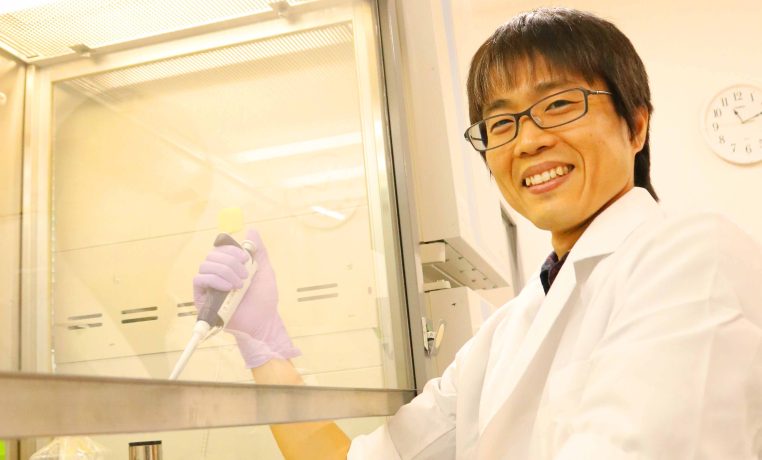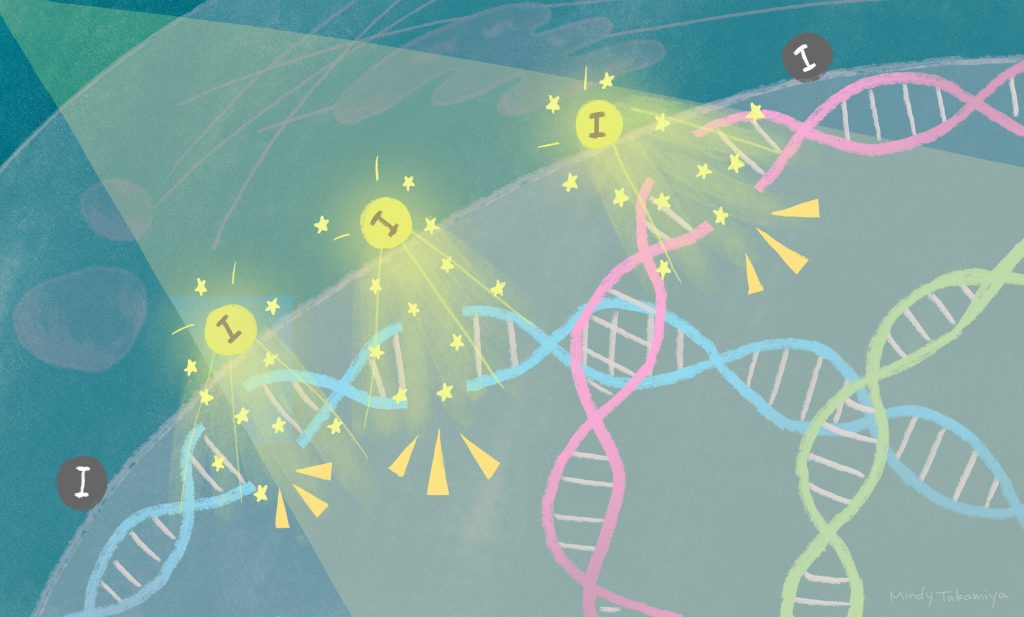Releasing Electrons from Nanoparticles to Fight Cancer
Program-Specific Researcher (Tamanoi Lab)
Yuya Higashi
Yuya Higashi
Yuya Higashi is working on the development of new radiotherapy methods with the iCeMS Tamanoi lab at Kyoto University. For this study, he developed a method to efficiently cause breaks in the DNA by generating electrons inside cancer cells. He found that when they used this method to cause breaks in the DNA of cancer cells, the cancer cells died within a few days, leading to the destruction of the tumor mass.

Please share with us the significance of your manuscript in terms of its research achievements, impact, or uniqueness.

For this paper, we succeeded in killing cancer cells with electrons by inducing Einstein's photoelectric effect in them, efficiently causing breaks in their DNA. In this method, iodine-containing nanoparticles are taken up into cancer cells which are then exposed to monochromatic X-rays. By adjusting the energy of the monochromatic X-rays to the optimum energy that iodine absorbs, a photoelectric effect occurs in the cancer cells, generating a large number of electrons from the iodine. We were able to show these electrons then cause breaks in the DNA of the cancer cells, thereby destroying the tumor mass.
Please tell us what was the most gratifying or inspiring moment for you during this research project.
The most exciting moment for me was when a tumor mass irradiated with X-ray disappeared after only three days. In the past, I had experimented with adding various anti-cancer drugs to tumor masses, but they never disappeared. The method described in this paper, which combines iodine-containing nanoparticles and monochromatic X-rays, seems to have a very high ability to kill cancer because it efficiently causes breaks in the DNA of cancer cells. We believe that this treatment method may be able to eliminate cancer that could not be eliminated by conventional methods.
Please tell us about the biggest challenge or problem you experienced while conducting your research. How did you overcome it?
The biggest challenge in this research was to destroy tumor spheroids, which are masses of cancer cells. Tumor spheroids, which are experimental models of cancers made to mimic real tumors, are resistant to treatment and difficult to destroy. However, we were able to overcome this difficulty by using our original iodine-containing nanoparticles and tissue-penetrating monochromatic X-ray. These nanoparticles can penetrate the cells in the entire tumor spheroid. In addition, the monochromatic X-rays we used are adjusted to an energy that is not absorbed by elements other than iodine, so that the X-rays thoroughly hit the center of the tumor spheroid. We believe that by combining these factors, the tumor DNA was able to be damaged extremely efficiently leading to the efficient destruction of the tumor spheroid.
Would you consider this work to be a turning point in your overall research direction? If so, how has your research direction changed as a result of this work?
Through this study, I learned that novel research can be done when researchers from various fields work together. Until this point, I had been doing research in the field of biology, but in this research new discoveries were made possible by collaborating not just with biologists, but also physicists and chemists, and successfully integrating each other’s knowledge and skills. I think that considering perspectives from other fields of research and whether they can be applied to one’s own research will lead to new discoveries.
Please describe the current situation of your career. What is your current position? How has the knowledge and experience gained at iCeMS influencing your career?
I am continuing to work towards developing new radiotherapy methods as a program-specific researcher in iCeMS Tamanoi Lab. At iCeMS researchers from diverse research backgrounds are gathered. It is an environment with no resistance to conducting cross-disciplinary research. For this paper as well, we were able to conduct new research by collaborating with researchers from various fields, including biology, physics, and chemistry. I think it has broadened my knowledge and experience, which was previously limited to molecular biology.
*All the information on this page, including the researcher’s affiliation, is current at the time of the interview.
Paper information
Iodine containing porous organosilica nanoparticles trigger tumor spheroids destruction upon monochromatic X-ray irradiation: DNA breaks and K-edge energy X-ray
Yuya Higashi, Kotaro Matsumoto, Hiroyuki Saitoh, Ayumi Shiro, Yue Ma, Mathilde Laird, Shanmugavel Chinnathambi, Albane Birault, Tan Le Hoang Doan, Ryo Yasuda, Toshiki Tajima, Tetsuya Kawachi and Fuyuhiko Tamanoi
Scientific Reports
Published: July 2021
DOI: 10.1038/s41598-021-93429-9